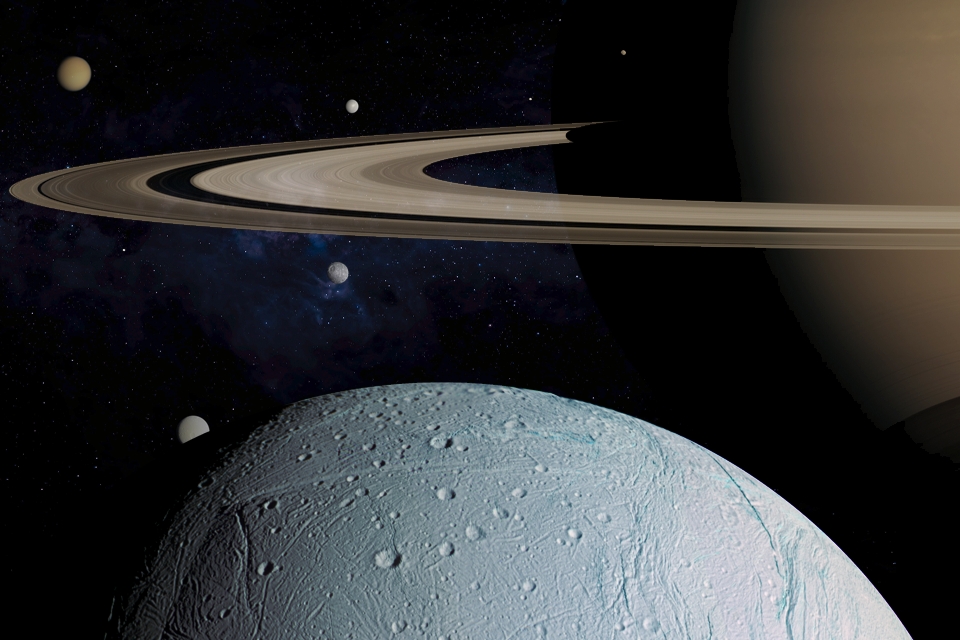Saturn is the sixth planet of the Solar System from the Sun, which is known for its amazing ring system. However, the system of its moons also deserves attention. There are many of them, they are all different and all deserve to be paid attention to. In addition, Saturn’s moons are actually closely related to its rings.

1. How many moons does Saturn have?
Saturn has the most moons among all the planets in the Solar System. In May 2023, astronomers confirmed the existence of 62 new bodies in orbit around it, so that their number reached 146 and it overtook Jupiter in this indicator. This has already happened several times — for example, in 2019. But each time the largest planet regained its leadership after a while.
The absolute majority of Saturn’s moons are small bodies, the size of which is measured in just a few kilometers. Their number grew rapidly in the second half of the XX and in the XXI century. In 1900, it was believed that the planet had only 9 moons, in 1980 — 17, and at the turn of the century — 30.
2. Which is Saturn’s biggest moon?
Saturn’s biggest moon is called Titan. Its diameter is 5,152 km, it is the second biggest moon of the Solar System, only slightly behind Ganymede, which orbits Jupiter.
Titan is the first known moon of Saturn. Christiaan Huygens discovered it back in 1655. This object is also interesting because it is the only moon in the Solar System that has a powerful atmosphere. In addition, it remains the only known celestial body on the surface of which liquid constantly exists.
3. Which moon of Saturn is the most amazing?
From a certain point of view, it is Titan that can be considered the most amazing of Saturn’s moons. It’s hard to find anything more amazing than a sea of liquid hydrocarbons surrounded by hills of “snow” formed when they freeze.
However, Saturn has several other wonderful candidates for the most amazing moons — for example, Hyperion, which has a very irregular shape and orbits the planet in a highly elongated orbit. Because of this, the duration of the day changes all the time.
We can also recall Iapetus. This moon is interesting because its two hemispheres are very different in their albedo: one of them is much darker than the other. In addition, there is a mountain range with a height of 13 km, which stretches around the entire equator of the moon.
And still, the primacy should be given to Mimas. This celestial body has on the surface the Herschel crater with a diameter of 396 km with a sufficiently high outer wall. Therefore, the moon is very similar to the “Death Star” from “Star Wars”.
4. Is there life on Saturn’s moons?
At least one moon of Saturn has an ocean of liquid water under its icy crust. We know this for sure, because it bursts through cracks in the ice in the form of geysers and flies far enough into space. We are talking about Enceladus, which has a diameter of about 500 km.
Moreover, in 2018, the Cassini spacecraft registered organic molecules in them when flying through the emissions of Enceladus geysers. And in 2022, it was announced that there was also phosphorus. All this does not mean that there is life on this moon, but the conditions for it there look better than anywhere outside the Earth. Subglacial oceans may also exist on Titania and Rhea.
5. How are Saturn’s moons connected to its rings?
Saturn’s rings consist of countless small particles, the size of which can vary from a few millimeters to kilometers. From a certain point of view, they can be considered as a collection of a huge number of small moons.
In addition, some fairly large moons move directly inside the rings. Pan, Atlas and Daphnis “cut” through the cracks in them, and Prometheus and Pandora move above and below the ring F in resonance, so they are sometimes called its “shepherds”.
In addition, the ring system could have formed from some large icy moon. A few hundred million years ago it came too close to the surface.
Follow us on Twitter to get the most interesting space news in time
https://twitter.com/ust_magazine
